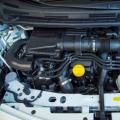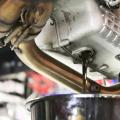There were only bulky electric and gas stoves with many disadvantages.
Glass ceramic panels made the work of housewives easier and became a godsend for designers.
The glass-ceramic panel has a lot of advantages:
- beautiful smooth finish;
- the ability to integrate the panel into kitchen furniture;
- quick change temperature regime, in contrast to the electric stove;
- no soot, unlike a gas stove;
- ease of cleaning the coating.
Low thermal inertia
The hotplates heat up and cool down quickly.
This saves the housewife's time and reduces the chance of burning food.
Thermal polarizing properties
Heat transfer is vertical. The hotplate heats up but the surrounding area does not, as there is no horizontal heat transfer.
Burners in glass ceramic hobs
A hotplate is a conditional concept for a hob. Only the marking of the heating zones is visible on the panel."Burner" is a flexible heating element hidden under glass-ceramics, laid on an asbestos base in the form of a spiral.
The following types of "burners" can be distinguished:
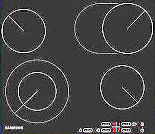 They can be round or have an extended heating zone. These hotplates allow you to cook in different sizes of pans.
They can be round or have an extended heating zone. These hotplates allow you to cook in different sizes of pans.
The high-temperature coil heats up red-hot in 10-12 seconds. Heating power of the burner with a diameter of 210 mm - up to 2.1 kW, 145 mm - about 1.2 kW. The hostess does not have to worry that the food in the five-liter saucepan will heat up unevenly, or the handles of the small saucepan will heat up so that it cannot be removed from the stove.
The rapid burner is the most widely used element by manufacturers.
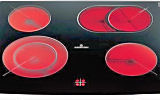 The heating element is a snake-shaped tape made of a special alloy.
The heating element is a snake-shaped tape made of a special alloy.
Heat is distributed over the work area in 4-7 seconds. Water heating on such a panel is much faster than on other types of panels. But, if a rapid burner on average consumes 1-1.5 kW per hour, the Hi Light element consumes much more - 1.5-2 kW per hour.
The Hi Light element is used by manufacturers, as a rule, for only a few models.
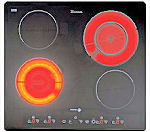 The high temperature coil is combined with a halogen lamp, which is a quartz tube filled with gas.
The high temperature coil is combined with a halogen lamp, which is a quartz tube filled with gas.
The lamp generates a large amount of heat, emitting a bright red glow. The element is powerful. Heating is instant.
For cooking French fries, fried meat, boiling water quickly, this panel is ideal.
 This development is unique as it is based on changing the electromagnetic field.
This development is unique as it is based on changing the electromagnetic field.
An inductor and an electric generator are hidden under the work surface.
The principle of heating food is that the atoms of the crystal lattice of the alloy from which the dishes are made vibrate under the influence of an electromagnetic field.
The bottom of the pan heats up, while the hob itself remains cold.
This element eliminates the possibility of food burning to the work surface, saves time and energy due to direct heating.
Functions and equipment of glass ceramic panels
Panels can be combined: three gas burners + one electric (or two gas + two electric). If you experience power outages, it is advisable to acquire just such a model.Not all manufacturers produce such panels, and their price is slightly higher than others, but you will have a guarantee that you will not be left without hot food in the event of a power outage.
By function, the hotplates can be divided into:
Thermostatic
Equipped with thermostat - temperature sensor. This keeps the temperature set from the control panel.
This function is very convenient for cooking dishes that require prolonged heat treatment at a constant temperature.
Variable heating zone
When using round dishes, contours of either a larger or a smaller diameter are activated; if it is necessary to use oval-shaped dishes, an additional heating segment is activated.
Such burners are convenient for cooking in patches and ducklings.
Equipment:
Cooking zone indicator lights
Residual heat indicator
Control system
Assistive devices
Types of assistive devices
Infrared sensorIt measures the temperature of the cookware and regulates it by increasing or decreasing the heating power.
Boiling automation
This device makes it possible to turn on the hotplate at full power, and after a specified time it will automatic shutdown parts of the power.
Safety system
It is installed to be able to block accidental switching on of the stove. This feature is very useful if there are small children in the house.
Automatic cooking
The initial weight of the product, the program number are set - and the food is prepared independently, without your participation. Half an hour before readiness, the heating element turns off, and the food reaches the residual heat.
The electronic timer gives a signal to notify you of the end of the process. 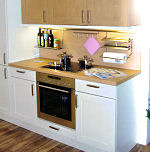 Hobs give consumers the chance to equip their kitchen workspace with maximum convenience. When developing a design project, it should be borne in mind that the hob and oven can be placed independently of each other.
Hobs give consumers the chance to equip their kitchen workspace with maximum convenience. When developing a design project, it should be borne in mind that the hob and oven can be placed independently of each other.
There are dependent and independent panels.
In dependent panels, the controls for the oven and burners are located side by side (on the oven body).
In independent panels, the oven and hob have different controls.
If you've chosen independent panels, you can let your imagination run wild. For example, if the oven is placed at chest level, it will be more convenient to pull hot baking sheets out of it, and if the hob is next to the cutting table, it will save a lot of time.
Some people prefer to place the hob in the center of the cutting table. Everyone can reach the level of maximum convenience for themselves.
You can choose between standard electromechanical rotary switches or touch field control for operating the hotplates and oven.
Precautions for use
- Do not subject glass-ceramic to strong, sharp impacts. No matter how strong the material is, with a barbaric attitude it can burst.Do not use the hob as a cutting board. Scratches from a knife can soon render the coating incapable of maintaining the panel's functionality.
Choose the right cookware. Discard aluminum and copper cookware, it leaves a metallic sheen on the panel that cannot be removed.
To avoid heat loss during cooking, choose cookware with a perfectly smooth bottom. The best choice - high quality stainless steel cookware. The bottom of such a dish is heavy and somewhat concave.
When heated, expansion occurs and the bottom straightens.
If your hob is not equipped with an infrared sensor, do not leave the cooking process unattended.
The glass-ceramic hob has no rims, and the liquid that "escaped" from the pan will spill onto the floor and, what is most dangerous, will get onto the neighboring burners and may cause the metal-ceramic to crack.
Use special ceramic compounds and scrapers to clean the panels. Scrapers are usually supplied with the plate.
If you don't have a scraper, you can use a disposable razor. Window cleaner can be used as a detergent.
The main thing is that after washing the surface, a layer remains on it that rejects fat.
Manufacturers and price of plates
- BOSCH
- ELECTROLUX
- SIEMENS
- ARISTON (Italy)
- VIKING (USA)
- ARDO
- ZANUSSI
- GAGGENAU
- MIELE
- GORENJE (Slovenia)
- BAUKNECHT
- FAGOR
Prices for glass-ceramic plates, like any other product, largely depend on the popularity of the manufacturer's name.
The more famous the name, the higher the level of assembly and reliability, the wider the range of services.
Happy shopping!
Boiling automation Automatic boiling on electric hobs.
There is a sensor under the hotplate that detects the heating temperature of the dishes, and at the right time reduces the power of the hotplate to the keeping temperature. Total cooking zones There are usually 4 cooking zones on the hob. However, there are models with 5-6 cooking zones. Domino hobs, as a rule, have 1–2 burners. Gas control of burners Gas control of gas burners automatically stops gas flow if the flame goes out for any reason. DOMINO design "Domino" - narrow hob modules that can be combined with each other on one table. A modular slab is assembled from various components. For example, an electric hob is connected to a gas one, a grill and a deep fryer are added. Safety shutdown of hotplates The self-deactivating device switches off the cooking zones or the entire hob after a certain period of inactivity or in case of overheating. Residual heat indicator During the operation of the hotplate, the corresponding residual heat indicator comes on, which remains on even after the hotplate is turned off until the hotplate temperature reaches a level safe for humans. Panel lock button A safety system that allows you to block the switching on of the burners serves to protect children from switching on the hob. WOK burner Presence of a hotplate designed to use a WOK pan.
The hotplate has a concave shape and increased power. It is found both on gas hobs and on electric ones. Grill zone The presence of a grill burner.
As a rule, this is a thick ribbed surface or a grate with heating elements located underneath. Hi Light hotplates Number of hotplates or Hi Light zones.
The burners have a heating element - a corrugated tape made of a special alloy. This element provides very fast heating. Hotplate Double crown Number of double crown burners.
"Double crown" is a gas burner that has two rows of flame. Hotplate Triple Crown Number of triple crown burners.
The Triple Crown is a gas burner that has three rows of flame. Gas burners Number of gas burners. The most common option is 4 gas burners. Halogen burners Number of halogen burners.
The halogen hob is powerful, heats up instantly and cools down quickly. Heating is provided by a high temperature coil combined with a halogen lamp. Double-circuit burners The number of double-circuit burners, when using which you can optionally include a heating area of \u200b\u200ba larger or smaller diameter, suitable for a large frying pan or a small saucepan. Induction hotplates The number of induction-heated electric burners.
During the cooking process, the bottom of the dishes is heated directly, and the burners themselves remain cold, which makes them absolutely safe. To use induction hobs, you will need cookware made of cast iron or enamelled steel. Ceramic burners Number of ceramic (glass-ceramic) burners.
The ceramic hob heats up almost instantly and is easy to clean. The disadvantages of glass-ceramic burners can be attributed to the fact that if the "escaped" liquid gets on the still not cooled surface of the burner, the panel may crack. Oval cooking zone Number of oval cooking zones.
On burners with an oval heating zone, when the switch is in the corresponding position, an additional segment of the heating element turns on, turning the round burner into an oval one. Three-circuit burners Number of three-circuit burners.
The hotplates have a variable heating zone in the form of three concentric circles. When using them, you can optionally include a heating area of \u200b\u200ba larger or smaller diameter. Cast iron burners The number of electric cast iron burners ("pancakes").
Cast iron burners heat up very slowly, often overheat, cool down for a long time. Short pause The presence of a short-term pause function.
By pressing the button, all cooking zones on the surface are switched to keep warm. Maximum power consumption Maximum power consumed by the hob.
Most modern hobs have a power of 2 to 5 kW. The higher the power rating, the less time it takes to cook. Panel material The working surface can be enameled, cast iron, steel, glass-ceramic or tempered glass.
Enameled surfaces are inexpensive and durable. Cleaning the enamel from liquid and droplets of fat is laborious; over time, scratches appear on the enamel.
Cast iron surfaces are generally inexpensive but difficult to clean.
On the surface of of stainless steel finger stains may remain. For care, special cleaning agents are needed.
Glass ceramics - the panel under which the heating elements are located. With strong boiling, the liquid spills and can flow over the sides or get onto an uncooled burner.
The cooking surface on which the burners are installed and which is covered with a layer of glass ceramic or tempered glass, called "gas on glass". The panel is easy to clean but scratches easily. Rated power The value of the nominal power consumption of the hob. This parameter determines the power that the device consumes during normal load. Rated power is measured in kilowatts. Switches The switches for controlling the burners can be rotary, touch-sensitive or recessed.
In inexpensive hobs are installed swivel switches (conventional rotary handles).
Recessed make it impossible to accidentally turn on the stove (you can only turn the extended handles).
FROM sensory the switches are enough to touch to turn on the hotplate, select the power level or heating zone. Frame The presence of a decorative frame around the perimeter of the working surface of the device. Some models do not have a frame, in which case the work surface cuts flush with the table top. Pot detection The presence of a sensor that determines not only the presence of dishes on the burner, but also the location of the dishes in the center.
In the event of a shift in the center or lack of dishes, the heating zone is immediately turned off. Pot size recognition Automatic selection of the cooking zone width for electric hotplates.
In some models of electric hobs, special sensors are installed that monitor the size of the dishes. Control panel location The location of the hob controls.
Panel in front more familiar to most users.
However, the panel posted sideways, less prone to pollution. Cooking zone timer The presence of a built-in timer for programming the cooking time.
A distinction is made between a timer with shutdown and a sound timer. Panel type Cooking surfaces are divided into gas, electric and combined.
Gas They are usually installed in houses where main gas flows or in private cottages where gas cylinders are used.
Electrical panels are usually installed if there is no central gas supply in the house.
Combined models have gas and electric burners. Touch control type Button control is presented in the form of touch buttons. Using the touch slider, you can more easily and clearly adjust the degree of heating. Cooking zone timer type Type of the built-in cooking zone timer.
In some models, the timer automatically switches off the hotplate by itself (the timer with disconnection), in others it only serves sound signal about the end of time (sound timer). Electric ignition type Electric ignition can be automaticwhen ignition occurs by turning the switch, and mechanicalwhen after turning the switch, pressing the dedicated button is required. Installation The work surface can be dependent or independent.
Dependent - a hob that often does not have burner switches. Such a surface is controlled from the control panel located on the oven.
Independent the hob has its own control panel and does not depend on the type of oven. Cast iron grates The presence of cast iron grates on the gas stove.
The heavy weight of the gratings and the inconvenience of cleaning them are compensated by their durability and strength, and a stable surface. Express hotplates Number of quick heat-up zones.
Express hotplates - hotplates that are different from the rest more power and shorter heating time. When heated, the express burner immediately turns on at full power, and after warming up to the set temperature, part of the power is turned off. Electric ignition The presence of a flame ignition device on gas burners using an electric spark.
The electric ignition built into the gas burner ensures ignition without the aid of matches.
Amazing glass ceramics
Today, traditional cast-iron pancakes are increasingly giving way to a new elegant material in kitchens - glass ceramics. How it happened that glass began to defeat metal, why new stoves heat up faster than old ones, how glass ceramics are produced and what are they afraid of - this is our story ...
Instead of an observatory - to the kitchen
It is curious that the material, which in the last quarter of the twentieth century. radically transformed not only the device of the electric stove, but even the very appearance of the kitchen, was not developed at all for domestic purposes. The German concern Schott Glass, the world's largest manufacturer of optics, has developed a new material Zeradure for telescopes. And only later the idea arose to use a similar material for the production of household glassware, making a hob from it. Of course, the materials that go to the needs of astronomers and those that top the stoves differ in a huge number of parameters, but their nature is the same. These materials - the so-called sitalls and astrositalls - are glass-crystalline structures with a wide range of unique properties.
Nowadays, glass-ceramic coatings for hobs are produced by two European companies - the already mentioned concern Schott Glass (trademark Ceran) and the French company Eurokera. Each of them has its own technological know-how, but in in general terms the process of producing a wonderful material looks like this: first, "green" glass is made in a glass-making furnace. In appearance, it differs little from ordinary glass, and it does not yet possess special properties either.
"Green" glass is cut to the shape specified by the customer, the edges are processed and the desired decor is applied. Wealth possible colors and shades allow the glass customer to show all their imagination and create a hob with their own unique face. Zodiac signs on Hansa hobs, ancient Egyptian frescoes on Zigmund & Schtain hobs - manufacturers' designers household appliances they create on glass like artists on an easel.
From the point of view of physics, the process of applying decor is the diffusion of a colored material into glass. It is clear that it is no longer possible to remove such a coating, which has "eaten" into the glass at the molecular level.
After decoration comes the most important stage - glass ceramization. Special crystals (which are the secret of the manufacturer) are added to it, which compensate for the expansion of the glass when heated. As a result, the finished glass-ceramic has a very low coefficient of thermal expansion.
Glass-ceramic is resistant to high temperatures, easily withstanding heating up to 600 ° C, and in a matter of seconds. For this material, it is as if the concept of "temperature shock" does not exist: a piece of ice placed on a heated glass-ceramic hob will not harm it.
But the list of amazing qualities of glass ceramics does not end there. This material perfectly conducts heat across the sheet, but very poorly along its surface. Such thermal conductivity is called anisotropic, and this feature is literally very good for us. After all, thanks to it, just a few centimeters from the hot burner to the glass ceramics, you can safely touch your hand, without any risk of getting burned.
Caution: glass ceramics!
Like any glass, glass-ceramics is a fragile material, but its safety margin is quite large. Glass ceramics withstands a static load of about 1 atm (for comparison: a water jet with a pressure of 0.75 atm knocks a person down).
Good results are shown by glass-ceramics in such discipline as shock loads. During factory tests, pans filled with sand with a diameter of 12 cm are dropped onto the hobs.However, what is performed in the laboratory on special equipment, where the parallel of the bottom of the pan and the plane of the glass is ensured, should not be done at home: a blow not with the plane of the bottom, but with an edge - and you you will have to order a new glass for the hob, and at the price it is so much that it is easier to buy a new one. In the practice of any service department, there are enough unfortunate examples when pans, knives and other kitchen utensils, suspended above the stove, fell on the hob.
Another classic case: a craftsman who has undertaken to hang an air purifier over the stove cannot find anything better than to stand with his feet on the glass-ceramic panel. The result is just as sad ...
For every taste and color
A variety of forms these days glass ceramic hobs allows you to choose what will satisfy even the most demanding taste. In addition to panels of standard sizes (about 58x52 cm), there are giants 78 or even 90 cm wide with a set of various burners (Fig. 1) and a domino panel for only two burners (Fig. 2). There are hexagonal panels, from Kuppersbush or Gaggenau (Fig. 3) or "boomerangs" from Teka (Fig. 4). Who said that glass-ceramic coating must be flat? The hob TT 75 VI from Teka has an integrated steamer, which is a kind of frying pan molded on the right side of the hob (fig. 5). Water is poured into the depression of the "frying pan" and the food covered with a lid is steamed.
 Figure: 1. Siemens hob
Figure: 1. Siemens hob
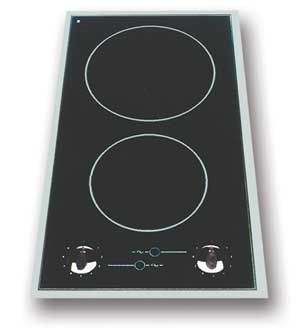 Figure: 2. ARDO hob
Figure: 2. ARDO hob
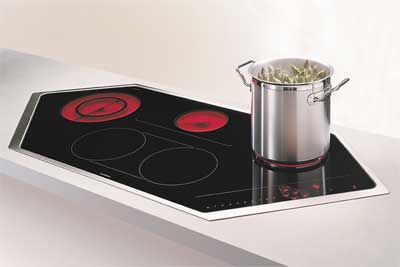 Figure: 3. Gaggenau glass ceramic hob
Figure: 3. Gaggenau glass ceramic hob
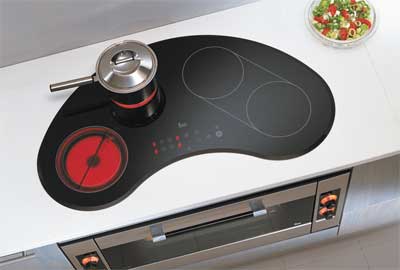 Figure: 4. Teka hob
Figure: 4. Teka hob
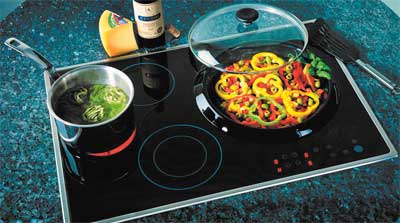 Figure: 5. Teka glass ceramic hob with steamer
Figure: 5. Teka glass ceramic hob with steamer
Show "under the glass"
Heating zones for glass-ceramic panels are also very diverse: round and oval, with and without an expansion zone (Fig. 6). Anyone who has ever seen a switched on glass-ceramic panel knows that through its glass from below the hotplate shines through with red heated threads. But, probably, even those who have had glass ceramics in the kitchen for a long time do not know what exactly is under the glass and how this burner looks.
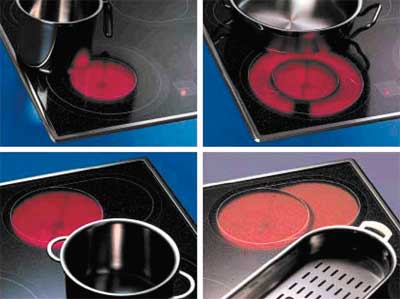 Figure: 6. Heating zones of various configurations
Figure: 6. Heating zones of various configurations
Now you have a rare opportunity to see what is under the glass: in fig. 7 before you is a training hob model made by one of the Moscow service centers. The glass-ceramic surface has been removed and replaced with ordinary plexiglass, and the work of the burners or their sections is imitated by the Duralight luminous tube used for decorating discos.
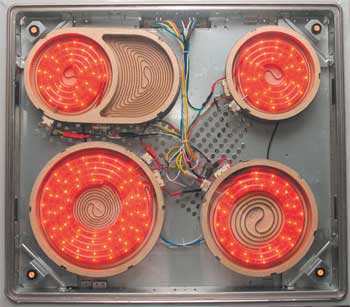 Figure: 7. The hob burners: view without glass
Figure: 7. The hob burners: view without glass
It turns out that under the glass, apart from the burners, there is practically nothing, only wires going to each burner. Moreover, the wires are drawn to the burners not from the control panel (it simply does not exist), but from somewhere below. Here we are faced with a very important concept for a potential buyer: a dependent and independent hob.
The panel that we see in the picture is dependent. It does not have its own control knobs, all the knobs for selecting the power of the burners are on the oven, without which the panel cannot work. It is all the time connected to the oven by the umbilical cord of electrical wires.
The hob, which has its own controls (knobs or, in the case of glass ceramics, touch controls), is independent. She doesn't need an oven at all. Therefore, if you are not fond of cooking and do not throw turkey parties at home, you can not spend money on buying an oven and buy only a hob.
If you decide to buy both, and you settled on the option with a dependent hob, be sure to ask if the hob and oven you have chosen are compatible. Of course, a competent salesperson will definitely find a compatible pair for you. But it never hurts to play it safe. Otherwise, the electronics of the oven and the electronics of the hob may not understand each other.
The hob burners may have different kind (Fig. 8), but all of them are united by the presence of an element that heats up under the action of a flowing through it electric current... In some cases, it is a thin metal spiral (Fig. 9). The burner can have an expansion zone in which there is an additional section of the spiral (fig. 10). If necessary, when larger dishes are placed on the stove, the hostess can use this section. Some AEG-Electrolux hobs have, for example, the Paella heating zone, named after Spanish cuisine. Paella is cooked in a large-diameter pan, and having an extended heating zone in the center of the hob comes in handy for this purpose.
 Figure: 8. Hotplates different types
Figure: 8. Hotplates different types
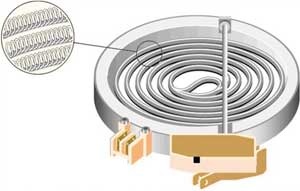 Figure: 9. Hotplate with heated spiral
Figure: 9. Hotplate with heated spiral
 Figure: 10. Hotplate with extension zone
Figure: 10. Hotplate with extension zone
By the way, the range of AEG-Electrolux Competence hobs includes a dependent hob with a record low Espresso heating zone. This heating zone with a diameter of only 10 cm is designed for both ordinary pans with a small bottom diameter and for Turkish coffee.
In many burners, instead of a spiral, a current corrugated tape with a width of about 7 mm is used as a heating element (Fig. 11). This hotplate heats up faster and often has a "brand" name - HiLight, Super-Quick or something like that. Due to the rapid heating of the band burners, some companies use only them in their hobs. For example, Electrolux does not use spiral burners at all.
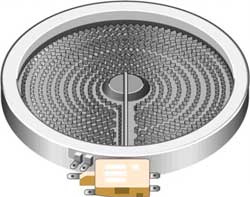 Figure: 11. Hotplate with heated belt
Figure: 11. Hotplate with heated belt
But the fastest heating is provided by burners with halogen lamps (fig. 12). These burners go into operation in a matter of seconds. A special name has been invented for them: the manufacturer of such burners, the German company EGO, gave them the designation HaloLight.
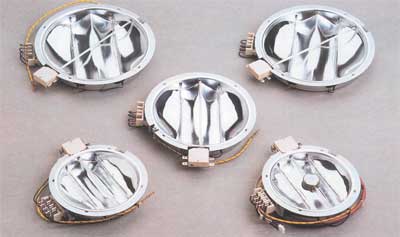 Figure: 12. Burners with halogen lamps
Figure: 12. Burners with halogen lamps
An interesting fact: the Miele company, which produces household appliances of the highest price category and an equally high degree of reliability, does not install burners with halogen lamps in its products, arguing that the lamp is a lamp and may someday burn out. In a technology designed for decades, this is unacceptable.
The observant reader may have noticed that each of the burners shown in these figures has a bar crossing it. This is a safety thermostat that limits the overheating of the hotplate. Although glass-ceramic is a heat-resistant material, excessive heat can destroy it if kept for too long. With a thermostat, the burner is protected from such a nuisance.
Smart hotplates
A modern hob is a complex product rich in ingenious technical solutions. Everything is subordinated to one task - to make the use of the panel convenient and safe for the hostess.
An indispensable attribute of almost any hob is the residual heat indicator for the hotplate. After the hotplate is turned off, the red trace of the heated coil or tape under the glass quickly disappears. How do you know if an already dark disc of the heating zone has cooled down or is it still dangerous to touch it? This will be reminded by the indicator, which will glow while the temperature of the heating zone exceeds 60 ° С.
In the simplest case, the indicator is an LED located near the heating zone. In more "sophisticated" models, a digital indication is used, usually in the form of the letter H (English Hot - hot), glowing near the image of the corresponding heating zone (Fig. 13).
 Figure: 13. Digital indicator of residual heat
Figure: 13. Digital indicator of residual heat
Nowadays, glass-ceramic panels are more and more often operated not by turning knobs, but by one light touch of a finger. The touch control (Touch Control) seems to be specially invented for glass ceramics (or maybe it is for him?). Elements that respond to touching it are located under the glass. This can be, for example, an optical element (Fig. 14) that is sensitive to the infrared ray reflected by the finger. There are capacitive-type sensor elements, a finger hitting the sensitive area of \u200b\u200bwhich changes the parameters of the control electrical circuit. Such sensory elements will not be fooled by wet or greasy hands.
 Figure: 14. Touch control of glass ceramics
Figure: 14. Touch control of glass ceramics
Having run her fingers over the sensory elements of her slab, the hostess, like a pianist, can play the desired part. For example, lock the hob so that a child does not turn it on when parents are away, or before cleaning the kitchen. Then you can wipe the surface with a rag without fear that the burners will turn on. To activate the blocking function (fig. 15), you only need to dial a certain combination of sensors.
 Figure: 15. Hob lock indicator
Figure: 15. Hob lock indicator
An interesting solution to the safety problem has been found by the designers of Neff hobs. Some models have a removable magnetic TwistPad with one rotary switch (fig. 16). To turn on any hotplate on the hob using a magnetic switch, simply turn it in the direction of the desired hotplate. The heating temperature is adjusted by turning the knob to the right or left. You can connect expansion zones, activate the "Memory" and "Timer" functions. And in order to prevent children from turning on the stove, the switch must be removed from the stove and put away.
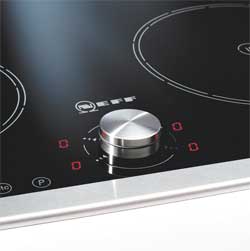 Figure: 16. Removable TwistPad (Neff)
Figure: 16. Removable TwistPad (Neff)
AEG-Electrolux hobs have a Stop + Go function, a kind of pause mode for the hob. Imagine that you are immersed in the cooking process, all the burners are on on the stove, and at this time your child is pouring a jar of jam on himself, or the phone suddenly rings, or you need to meet guests ... In a word, you urgently need to tear yourself away from the stove. How to leave the kitchen without risking ruining the dish? With one click on the Stop + Go button, you transfer all heating zones to a low-temperature mode, so that during your absence on the stove nothing boils away, does not burn or digest. To return the hotplates to their original heating modes, just press the same button again. Electronics will remember everything, and the culinary process will resume.
What if it happened that the boiled liquid burst out of the pan and spilled onto the control panel? In this case, the safety automatics, which are equipped with AEG-Electrolux hobs, will work: there are several sensors on the surface of the panel, the ingress of liquid on which is regarded by the control system as simultaneous pressing of several sensors at once. This action is considered invalid and the panel is disabled.
But the most amazing property of modern stoves is the ability to recognize the presence of metal dishes on the burner. Here's how it happens (fig. 17): inside the burner there is a so-called "measuring loop", which is a frame through which an alternating electric current flows. When a conductor loop, for example, a metal pan, enters the field, the current parameters change, which is recorded by the control electronics. A hotplate equipped with such a sensor will not turn on if there are no dishes on it, or if it is too offset from the center of the cooking zone (fig. 18).
 Figure: 17. Device for recognizing metal dishes
Figure: 17. Device for recognizing metal dishes
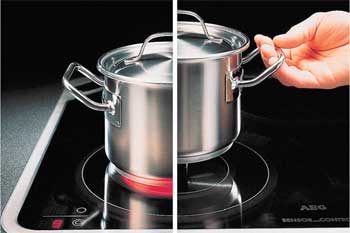 Figure: 18. Cookware recognition burner (AEG-Electrolux)
Figure: 18. Cookware recognition burner (AEG-Electrolux)
Some Bosch Siemens hob models are equipped with the kochSensor infrared cooking sensor, which directly measures the temperature in the pan. The heating zones work until the set temperature is reached, after which the temperature is maintained at an optimal level. This is very convenient: nothing escapes, even milk, and does not boil over due to too high a temperature. When the heating zone reaches the set temperature, an audible signal sounds and boiling is maintained in automatic mode.
Another Bosch innovation is the TermoControl frying system (which is called bratSensor in Siemens panels). The sensor automatically regulates the temperature of the hotplate, you just need to select the mode: Min - for frying meatballs, sausages or fried eggs, Med - for breaded dishes, fish, schnitzels, frying, vegetables, and Max - for potato pancakes, fried potatoes, steaks or turkey breast.
Automatic boiling is the function, thanks to which the hostess achieves the desired result faster, and the stove uses less energy. At the very beginning, when a certain heating mode is turned on, the hotplate works on maximum power... When the water in the pan has boiled, the burner switches to its normal operating mode, periodically switching off to maintain the temperature at the required level (fig. 19). Many models of modern electric stoves are equipped with similar systems.

Figure: 19. The principle of operation of automatic boiling
What if the water in the pot has completely boiled away? AEG-Electrolux hobs have such an original safety function as a boil-off sensor. This function using the display and sound signal will inform the hostess that there is no more water in the dishes, and will automatically turn off the heating of the corresponding zone.
What is glass ceramics afraid of?
For all its undoubted advantages, glass ceramics has several vulnerabilities. She is scared:
- point strike;
- constant mechanical stress;
- frozen sugar;
- scratches (crystals of salt, sand);
- repeated heating of a dirty surface (with traces of salt and metals).
If food gets on the glass-ceramic surface, you need to remove it as soon as possible with a special scraper, which should be purchased as an essential accessory for caring for your stove.
Do not use steel wool, abrasive sand or other similar materials to clean the surface. Use wipes and chemicals specifically designed for this purpose.
There are also protective agents that form on the glass protective filmthat makes cleaning easier and protects the glass from damage from molten sugar.
Glass ceramics and heating elements used in hobs
The relatively recent appearance of glass ceramics on the domestic market in comparison with Western Europe and its subsequent rapid spread generated a lot of rumors, often not related to reality. In fact, for a competent choice and use of glass ceramics, a small amount of information given in this article is enough.
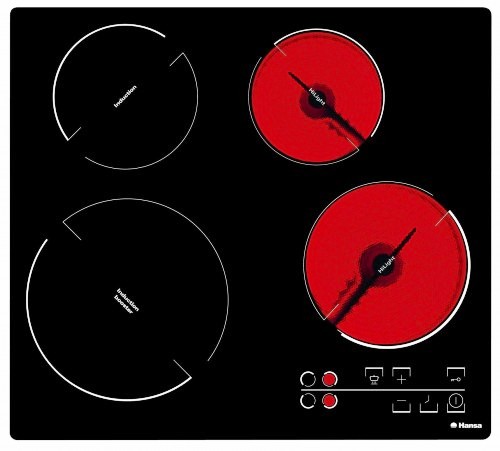
Typical glass ceramic hob with HiLight heating elements
When choosing a new modern work surface, most potential buyers first of all pay attention to the fact that, unlike other household appliances, almost all hobs are almost identical in appearance. This is due to the fact that the top sheet of a special, most often black material, which, in fact, is called glass ceramics, is produced by only two companies in the world - Schott in Germany (Ceran trademark) and Corning in the USA and France (EuroCera trademark and " k ").
In our region, mainly devices with Ceran glass-ceramic panels are offered, which have extremely positively recommended themselves on the market. Thus, manufacturers of household appliances only order the materials they need from these factories. This means that the quality and properties of the upper glass-ceramic sheet are the same for all brands, the differences are due to the heating elements used, circuitry and other internal electronic filling.
The glass-ceramic sheet itself is made mainly from natural raw materials such as, for example, quartz sand. Manufacturing in a simplified form is the following process: from a mixture of raw materials, molten glass is smelted, which enters the kiln for firing.
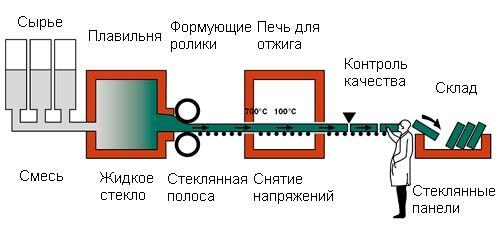
The first stages of the production process
Subsequently, a glass tape is formed from it, which is cut into blanks according to the dimensions required by the customer. Then the logo and the so-called decor are applied to the sheet, after which the base is ceramized, and as a result, a glass-ceramic panel appears.

Final stages of the production process
In most cases, the consumer sees it in black, but a number of manufacturers offer white, colored and even mirrored panels. One of the latest innovations from the Schott factory is transparent glass ceramics, which opens up new possibilities for designers of household appliances.
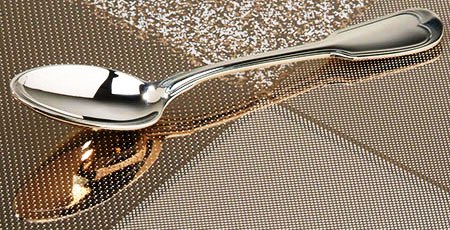
Transparent glass ceramics
Properties
The main advantages of glass ceramics, which can be used in hobs, are ease of cleaning, aesthetics, safety, economy and durability. This is achieved due to properties such as heat resistance and resistance to sudden changes in temperature, up to 750 ° C (this allows you not to be afraid of even getting ice cubes on the heated burners). In addition, the material has a very low coefficient of thermal expansion, which almost completely eliminates cracking due to changes in geometric dimensions.
In addition, glass ceramics are extremely resistant to regular mechanical stressaccidentally hitting pots and pans. Thus, Ceran surfaces withstand static loads up to 25 kg / sq. cm, impact - equivalent to the fall of a saucepan weighing 1.8 kg from a height of 50 cm. However, when a heavy object hits the edge of the panel, small chips may appear; in some models, this problem is solved by a metal edging, which can have a different color.
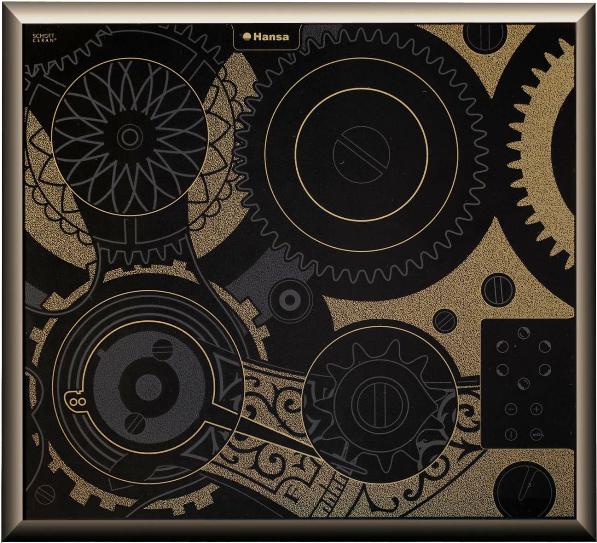
Glass ceramic panel with metal edging
Another unique property of glass ceramics is that due to the low transverse thermal conductivity, the areas adjacent to the cooking zones remain relatively cool during the heating of the dishes. This significantly reduces the likelihood of accidental burns and allows you to instantly wipe off boiled water or broth without fear of setting fire to the towel. Also, since heating only occurs where it is needed, energy efficiency is significantly increased, it becomes possible to use touch-sensitive controls, which would not be possible with traditional materials such as, for example, steel. In addition, as an additional safety measure, manufacturers provide residual heat indicators to prevent touching areas of the panel that are still hot.
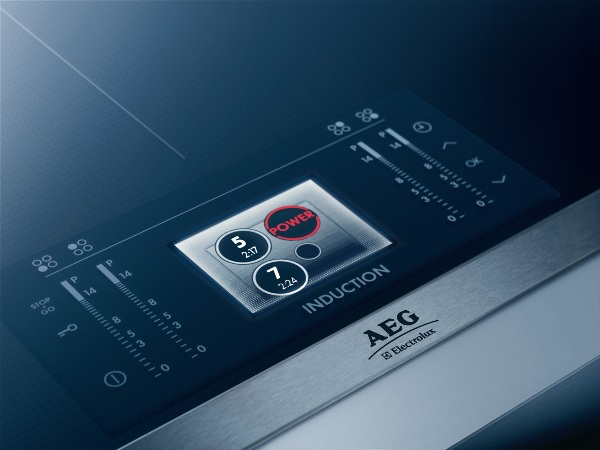
Hob with integrated LCD screen
However, glass ceramics puts forward certain requirements for the utensils used, first of all for its bottom - it should be flat, as smooth as possible and thick enough to distribute heat evenly (the ideal thickness is 2-3 mm for enameled dishes and 4-6 mm for stainless ). Glass containers are poorly suited for glass ceramics due to their relatively low thermal conductivity; it is also not recommended to use pots and pans with a copper and aluminum bottom, since in some cases they can leave hard-to-remove metal particles on the surface. This will not affect the performance of the panel, but may degrade it. appearance.
Care
Almost the only serious danger to glass ceramics that can arise on a daily basis is the so-called sugar chips - the result of sugar baking. They do not affect the operation of the panel, but they can ruin its surface, and, moreover, they are practically impossible to remove at home. This means that everyone's favorite preserves and compotes will need to be prepared with special care.
In general, proper maintenance is sufficient to extend the life of the panel and maintain its attractive appearance. First of all, it is necessary to remove all dirt from the hob, and it is advisable to do this immediately after cooking, as soon as the residual heat sensors go out. To do this, just apply a few drops of non-abrasive detergent and wash the panel with a paper kitchen towel or clean cloth.
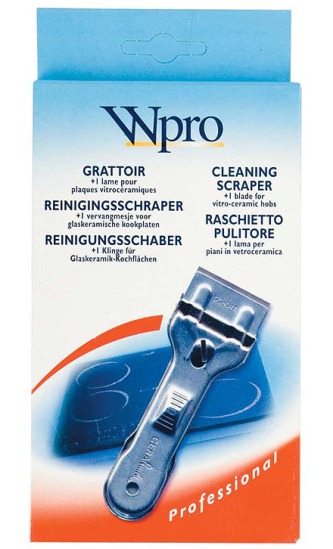
Special scraper for cleaning glass ceramic panels
Stubborn stains can be removed with scrapers and sponges specially designed for glass ceramics. At the same time, the use of hard sponges (the rough side of an ordinary kitchen sponge) and abrasive cleaning agents is strictly prohibited. Also, aggressive household chemicals used, for example, for cleaning ovens, are not suitable. A list of certified products can be found on the Schott website.
Heating elements
In modern devices, three types of heating elements (HE) are used: fast heating (HiLight), halogen (HaloLight) and induction (Induction). Let's figure out what disadvantages and advantages they have.
This type of NE is the cheapest and most common in modern hobs. It is a corrugated metal tape that heats up when an electric current flows. They provide a fairly quick set of temperature, however, the energy supplied to the dishes is regulated by the duty cycle of the NE, since it works only on full power... This means that, unlike gas burners, where food can be cooked on a constant "low" heat, in glass-ceramic with HiLight NE it is periodically switched on for a certain period of time, and the lower the temperature required for cooking, the shorter these intervals will be.

Appearance of working HiLight heating elements
This feature is partly offset by significant heating inertia and massive dishes. The disadvantages of HiLight include the high temperature of the hob (touching a hot burner will cause serious burns), as well as difficulty in cleaning: if used carelessly, dirt can burn and have to be removed with special scrapers.
HaloLight
Less common are HaloLight NEs, which are essentially halogen lamps. They, in comparison with HiLight, provide faster heating and cooling, however, they have one significant drawback - a limited resource, which is noticeably smaller than that of other NEs. In addition, the disadvantages of HiLight are fully inherent in "halogen", so manufacturers prefer other types of heating in their appliances, and now it is very difficult to find a halogen hob. Some brands, such as Miele, for example, refuse them altogether.
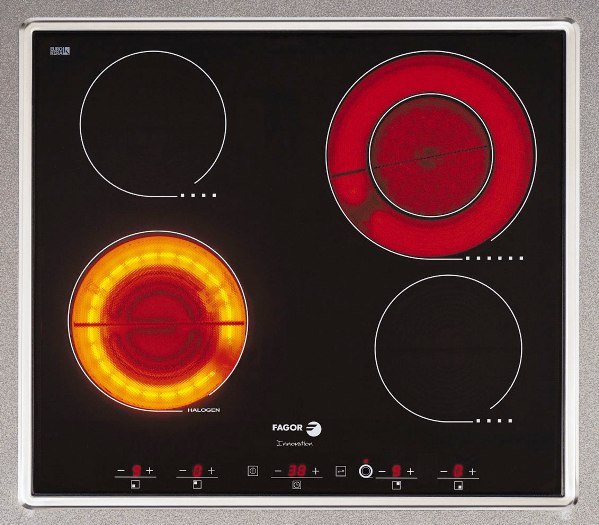
Halogen (bottom) and HiLight (top) heating elements
Induction heating
The most technologically advanced and expensive type of NE is induction, in which the dishes are heated using an electromagnetic field created by a kind of transformer. Its primary winding is an induction coil located under the glass-ceramic surface, the secondary winding is a frying pan or saucepan located on the hob, in the bottom of which eddy currents arise, which increase the temperature.
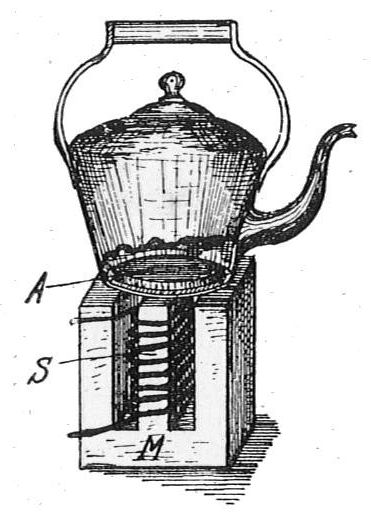
Drawing for one of the first patents for induction heating of cookware (1909). A coil of wires S creates a magnetic field in the core M, inducing currents in the bottom of the kettle A
Thus, without dishes, heating simply will not flow, and if there is one, only where it is. In this case, only the dishes are heated, from which, in turn, the panel itself is heated. This significantly reduces the likelihood of getting a burn, reduces the laboriousness of cleaning the surface, since dirt does not bake into glass ceramics. It should be noted that you should not be afraid of electromagnetic effects on the body - the radiation of the induction panel is less than that of a household hair dryer.
A significant advantage of induction heating elements is a quick set of temperature, even in comparison with gas burners. At the same time, a high accuracy of temperature control and extremely low inertia are achieved, which is achievable only on gas hobs. Another pleasant function is the mode for a short-term increase in the power of the burner (the so-called booster or power, intensive heating) - it allows you to instantly heat up the pan, boil water in just a few minutes.
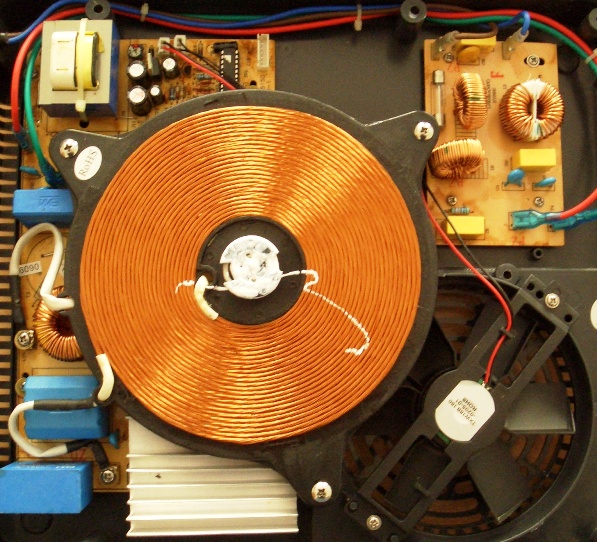
The appearance of the induction coil of a modern hob
Induction - 3:16 min and 134 Wh
Gas stove - 4:50 min and 258 Wh
Ceramic - 7:28 min and 178 Wh
Cast iron burner - 7:40 min and 241 Wh
Despite the advantages, induction hobs also have a number of disadvantages, which include the high price and the need to choose suitable cookware with a ferromagnetic base made of cast iron or steel. Pots made of glass, copper and aluminum, as well as many modern non-stick pans, do not have this property and cannot be used in conjunction with an induction heating element.
One of the variants of the "induction" pictogram
When buying cookware, remember that, as a rule, accessories suitable for induction hobs are marked with a special pictogram. It is quite simple to check the kitchen utensils available at home - it is enough to bring a magnet to the bottom, and if it sticks, then these dishes can be safely used.
Today, there is a wide variety of kitchen electric stoves on the home appliance market. But how to choose from the great variety the one that would satisfy your needs as much as possible and cost within reason? In this review, we will try to give you a number of tips that will be useful.
A standard kitchen electric stove, as a rule, consists of two elements that are functionally independent of each other - the hob and the oven. All modern kitchen stoves are divided into built-in and free-standing, they are also glass-ceramic and classic (with cast-iron heating elements and an enameled work surface). However, let's go in order.
As already mentioned, the hob can be either covered with glass ceramics or enamel. According to the cost criterion, enameled surfaces are cheap, as well as budget unlimited tariffs. With classic electric stoves, the burners heat up and cool down slowly, thereby slowing down the cooking process. Glass ceramics have obvious advantages. This kind of surface differs from electrical one in greater thermal conductivity. The process of use is simplified by convenient and accurate temperature control. As a rule, glass-ceramic panels have electronic control and almost all are equipped with residual heat indicators. Cleaning such a surface is reduced to an absolute minimum. But unlike the enameled surface, glass-ceramic is rather fragile and it is necessary to avoid impacts of hard, heavy objects.
Hobs can also be classified into independent and dependent ones. The main difference between them is that for dependent cookers, the control panel with mode controls is located on the oven, and for independent ones, on the hob. In this case, the knobs can be in the form of rotary switches and in the form of touch switches, which are activated with one light touch.
Freestanding electric cooker or built-in? We note right away that the location of the plate does not affect its functionality in any way. Freestanding stoves are cheaper, but built-in ones look prettier and more harmonious. The built-in stove also has the advantage that its oven can be taken out to the side.
What are the hotplates? The hob comes with a different number of burners: two, three, four, and sometimes five. The choice here depends only on individual needs. Heating zones are stationary and variable. Electro-glass stoves differ from gas stoves in that pots of different diameters can be selected for the same burner. On a small circle large capacity will warm up unevenly. Therefore, the burners are made both single and double-circuit. The heating area can be switched on with either a larger or a smaller diameter, which is most suitable for a small saucepan or a large frying pan. There are also burners with an oval heating zone, in which the corresponding switch position turns on an additional segment in heating element and thus making a round burner oval. This function ensures uniform heating of trays for cooking fish, ducklings, etc.
Also, burners are induction, halogen, Hi-Light and rapid. Most of the electro-ceramic hobs are equipped with rapid burners that heat up in a matter of seconds and cool down just as quickly. Hi-Light burners heat up three times faster than rapid burners. A high-temperature spiral is installed in halogen ones, which heats up and cools down almost instantly. This hotplate has even more power. For induction hobs, the work is based on the induction of a magnetic field coming from a generator, which is located under the ceramic surface. Buying a stove with such burners is the same as purchasing a Beeline gold number and emphasizing your taste. The hob of such a stove always remains cold, since the electromagnetic flow is directed only to the bottom of the dishes installed above it. However, there is one drawback - the rather high cost. But it is not necessary to buy a fully induction hob, one such hob on a regular hob is enough.
All hobs have residual heat indicators. They show how much the off zone has cooled down. It can also be used for light heating. Thanks to the infrared sensor, you can regulate the heating, maintaining a certain temperature regime.
Glass-ceramic hobs may have additional functions... Infrared temperature sensor. It measures the temperature of the cookware installed on the hotplate and adjusts the heating power. Accidental activation of the oven and cooking zones can be blocked by the security system. The boil indicator allows you to turn on the hotplate at full power, and after a certain period of time, part of the power is automatically turned off by the device. Modern electric stoves have a lot of different useful functions, which everyone chooses individually according to their needs.


